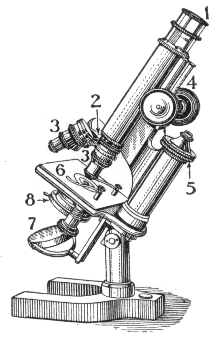Difference between revisions of "AY Honors/Microscopic Life/Answer Key"
From Pathfinder Wiki
< AY Honors | Microscopic LifeAY Honors/Microscopic Life/Answer Key
m (/* 2. Be able to identify the following parts of a microscope and explain or demonstrate the function of each: eye-piece or ocular, objective, body tube, nosepiece, stage, diaphragm, base, focus knob,) |
m (/* 2. Be able to identify the following parts of a microscope and explain or demonstrate the function of each: eye-piece or ocular, objective, body tube, nosepiece, stage, diaphragm, base, focus knob,) |
||
| Line 2: | Line 2: | ||
==1. List four major types of microscopics. What are some of the characteristics of each? Be able to identify the different types of microscopes from pictures, or visit a laboratory in a university or industry which has these microscopes.== | ==1. List four major types of microscopics. What are some of the characteristics of each? Be able to identify the different types of microscopes from pictures, or visit a laboratory in a university or industry which has these microscopes.== | ||
==2. Be able to identify the following parts of a microscope and explain or demonstrate the function of each: eye-piece or ocular, objective, body tube, nosepiece, stage, diaphragm, base, focus knob, and arm.== | ==2. Be able to identify the following parts of a microscope and explain or demonstrate the function of each: eye-piece or ocular, objective, body tube, nosepiece, stage, diaphragm, base, focus knob, and arm.== | ||
| − | [[Image:Mikroskop.png]] | + | [[Image:Mikroskop.png|frame| |
| + | 1. eye-piece or ocular<br> | ||
| + | 2. objective turret, or nosepiece<br> | ||
| + | 3. objective lenses<br> | ||
| + | 4. coarse adjustment knob<br> | ||
| + | 5. fine adjustment knob<br> | ||
| + | 6. object holder or stage<br> | ||
| + | 7. mirror<br> | ||
| + | 8. diaphragm and condenser | ||
| + | ]] | ||
| + | ;The eyepiece: The part of a microscope that a user looks into. (1) | ||
| + | ;Objective: (3) | ||
| + | ;Body Tube: | ||
| + | ;Nosepiece: (2) | ||
| + | ;Stage: (6) | ||
| + | ;Diaphram: (8) | ||
| + | ;Base: | ||
| + | ;Focus knob: (4 and 5) | ||
| + | ;Arm: | ||
| + | {{TODO|edit the picture and renumber so the parts we need are in the order presented here}} | ||
==3. Know how to calculate the magnification of a compound microscope. Calculate the magnification of the microscope you use for this honor.== | ==3. Know how to calculate the magnification of a compound microscope. Calculate the magnification of the microscope you use for this honor.== | ||
Revision as of 01:56, 28 October 2006
1. List four major types of microscopics. What are some of the characteristics of each? Be able to identify the different types of microscopes from pictures, or visit a laboratory in a university or industry which has these microscopes.
2. Be able to identify the following parts of a microscope and explain or demonstrate the function of each: eye-piece or ocular, objective, body tube, nosepiece, stage, diaphragm, base, focus knob, and arm.
- The eyepiece
- The part of a microscope that a user looks into. (1)
- Objective
- (3)
- Body Tube
- Nosepiece
- (2)
- Stage
- (6)
- Diaphram
- (8)
- Base
- Focus knob
- (4 and 5)
- Arm
3. Know how to calculate the magnification of a compound microscope. Calculate the magnification of the microscope you use for this honor.
4. Define the following microscopic terms: slide, coverslip, wetmount, fixing, staining, oil immersion, unicellular, multicellular, cilia, flagella, plankton.
- slide
- coverslip
- wetmount
- fixing
- staining
- oil immersion
- unicellular
- multicellular
- cilia
- flagella
- plankton

